Shipyard Employment eTool
Hanging Staging (Marine) >> Key Components: Considerations Component 3. Strut Connections
Key Components: Considerations
Component 3. Strut Connections
General Considerations
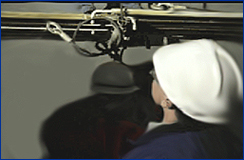
Check all strut connections.
Photo courtesy of OSHA.
Stability in a marine hanging staging platform is achieved in part by the number of adjacent platform systems. The tendency of any cable-suspended staging to sway, whether during installation, disassembly, or use, must be considered by the Qualified Person when a particular installation is being designed.
In general, the more tiers and sections of marine hanging staging that are tied together, the more stable the staging.
Conversely, a failure of one component or section of marine hanging staging may damage other portions of the staging.
Also, operations such as the hoisting and lowering of materials near the marine hanging staging could cause it to move and widen the gap between an unguarded working side of the stage and the adjacent solid structure.
Tie-ins should be installed to stabilize the marine hanging staging whenever lateral movement could compromise fall protection systems or the integrity of the scaffold or its component parts.
Struts: Critical Connections
Properly securing platforms to struts and connecting struts to suspension cable assemblies are critical aspects of safe marine hanging staging. Struts form the bearing for the staging planks. The sequence of their installation and the manner in which they are connected to the suspension cables is critical to the safe installation and use of the staging.
Definitions:
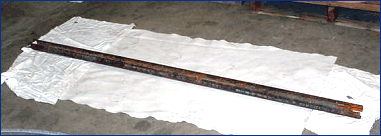
Strut.

Basic strut pin.
Photos courtesy of VSRA.
More information:
- View and/or print Illustration 8 of a strut pin connection.
- View and/or print Illustration 9 of a strut pin connection, with backing rod and suspension cable.
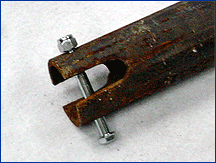
Strut and strut pin.
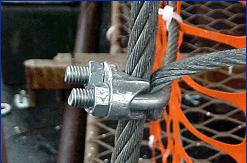
Cable clip and backing rod.
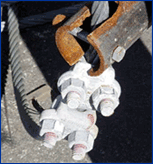
Strut secured to cable.
Photos courtesy of VSRA.
- Cable clips and backing rods to support the struts must be installed at predetermined intervals along the length of the suspension cables before being hoisted by the rope walker to overhead attachment points.
- The struts that support the lowest level of platforms should be attached to the suspension cable assemblies first, and an entire tier of platforms should be put in place and secured to the struts before erecting the next level. This ensures the degree of angulated cable necessary when overhead attachments such as S-hooks and pork chops are used to hang suspension cable assemblies. It also minimizes horizontal sway in the staging generally.
- Rough edges on the struts should be smoothed by grinding, machining, or other methods so that the struts do not abrade the suspension cables.
- Cable clamps and backing rods that support the struts should be installed in pairs, close together, and tightened to not less than 90 foot-pounds and not more than specified by the manufacturer.
- Wire cable used for backing rod assemblies must be of the same size as the suspension cable, and wire cable clips must be sized appropriately to the suspension cable.
- U-bolt cable clamps are used to support the struts at intervals along the suspension cables. In marine hanging staging, the clamps must be the same size as the suspension cables and spaced close to each other and applied with the saddle on the live end of the cable (in this case, the suspension cable itself), not the backing rod [29 CFR Part 1915.112(b)(3)].
- When U-bolt clamps are used to attach a cable assembly to an S-hook, the minimum spacing requirements for wire rope clips as presented in Table G-6 (referenced in this section of the standard) apply.
-
The strut pins, though not designed or intended as primary, load-carrying elements of the scaffold, must be capable of withstanding the forces during installation, disassembly, and use (e.g., the minor angle of suspension cable when attached to an overhead with S-hooks or pork chops, and the potential for side-loading from material handling operations where a suspended load may hang up on a portion of the staging system).
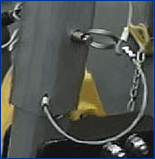
Strut pin.
Photo courtesy of VSRA.
- The strut pins must provide a positive closure, such as a bolt with a locking nut, that will not disengage the struts from the suspension cables.

